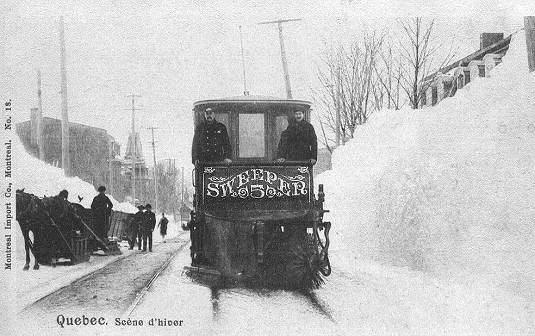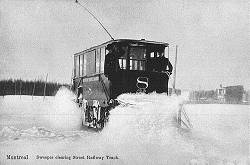

In the winter months, snow on tram tracks can sometimes be a problem. In the US, Canada and northern Europe this problem was solved by the use of trams known as snowbrooms or snow sweepers.
The tram consisted of a body, usually mounted high on its trucks, under which at each end revolving brushes made of rattan were mounted at an acute angle, looking rather like large bottle brushes. A major manufacturer of these cars in the early 1900s in the U.S, both for home use and for export, was the J.G.Brill Company. They constructed about 360 such vehicles at the cost of around eleven hundred dollars each. Their cars had three motors, two for driving the tram and a third for powering the brooms. Brill preferred what is known as short broom cars, i.e. the broom at each end covered one rail and half the track, both being used at the same time. Two ex-Brussels Brill snowbrooms have been preserved, one in the Brussels Transport Museum in Belgium and one at the National Tramway Museum at Crich in England.
 Our postcard shows Sweeper car 5 of the Quebec tramways and is captioned in French "Scène d'hiver" (winter scene). As can be seen it is a short broom type. The card was published by the Montreal Import Company and is number 18 in their series, having an undivided back and dating from around 1902. The smaller view is also a card from the Montreal Import Company, their number 296, and dates from a little later. The caption reads "Sweeper clearing Street Railway Track". This tram is car 8 of the Montreal Street Railway. It is very similar to the Quebec car, with the snow being swept at both ends confirming it to be a short broom type.
Our postcard shows Sweeper car 5 of the Quebec tramways and is captioned in French "Scène d'hiver" (winter scene). As can be seen it is a short broom type. The card was published by the Montreal Import Company and is number 18 in their series, having an undivided back and dating from around 1902. The smaller view is also a card from the Montreal Import Company, their number 296, and dates from a little later. The caption reads "Sweeper clearing Street Railway Track". This tram is car 8 of the Montreal Street Railway. It is very similar to the Quebec car, with the snow being swept at both ends confirming it to be a short broom type.
Other U.S. manufacturers, such as the G.C.Kuhlman Car Company (acquired by Brill in 1904) and the McGuire Manufacturing Company (from 1904 Mountain and Gibson in the U.K.), preferred the long broom which covered the whole track with one broom (or two side by side) driven at the front only. The McGuire snowbroom was a patented design (U.S. and U.K.) having an angular wooden body mounted high above the track on a rigid steel frame. An extra motor powered the brooms using a sprocket and chain drive. In addition the cars had extending wooden side ploughs (U.S. plows) to push the swept snow clear of the tracks. These side ploughs were folded back against the car sides when not required. McGuire claimed that their car was "guaranteed to remove eighteen inches of snow from any tramway track".
Some tram systems built there own snowbrooms by converting old passenger trams. The London County Council tramways in 1926 created some 21 snow sweeper cars from redundant B class double deck trams (see Works Car photos). The top decks were removed and the bodies raised nine inches by inserting timber baulks between the trucks and the bodies. The sweeper gear, made by the Kilmarnock Engineering Company, comprised long brooms that were retractable using a worm-wheel drive operated by hand wheels on the platforms, the broom at the front being lowered when required. These brooms were at a 15 degree angle and were rotated by a chain drive from the axles via gears to reverse the direction of rotation, so that snow was brushed forward and to the left of the direction of travel as the car moved. One car, 022, is preserved at the National Tramway Museum but restored back to its open top B Class condition as car 106.
Another type of works tram is the sprinkler or water car, used in dry periods to wash dirt from the tram tracks. The tram carried a large tank of water and sometimes had similar rotating brushes to a snowbroom, so could easily be mistaken for one and indeed sometimes was used as such.
Some systems used cars with a fixed snowplough. In this case either a diagonal beam (a shear plough) or a V shaped unit (a nose plough) was fitted to the front of the car to push the snow off the tracks. Again J.G.Brill built a number of these (about 150) and some companies such as the L.C.C. converted old passenger cars (L.C.C. had 18 built from ex C class trams). Indeed today Zürich tramways have four works cars converted from Swiss standard passenger cars, which can be fitted with shear snowploughs.
![]() Go to Postcard Of The Month Index
Go to Postcard Of The Month Index